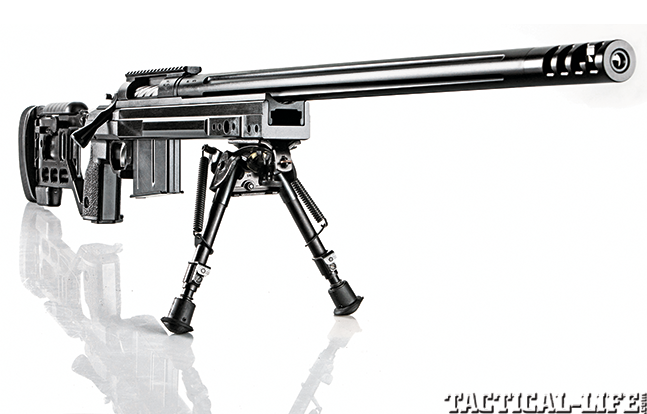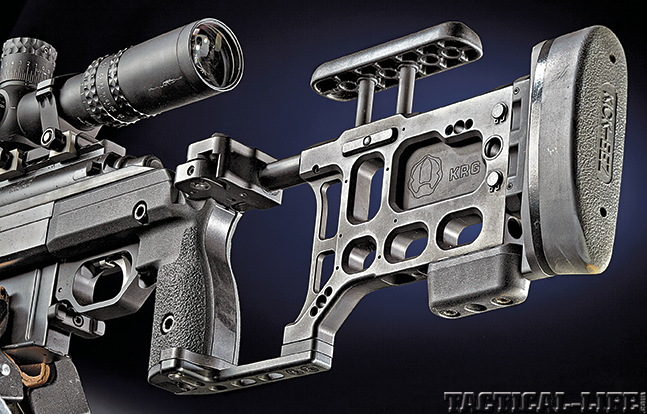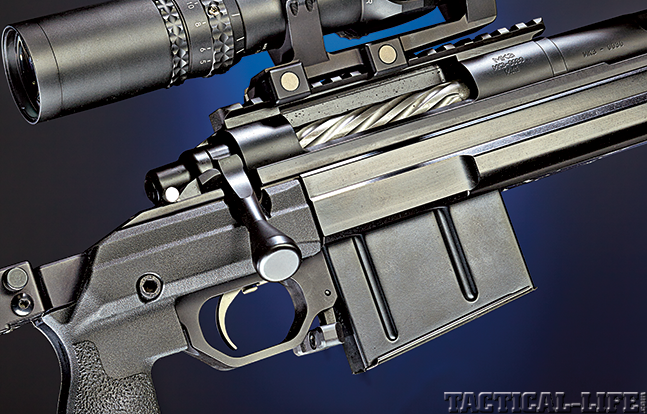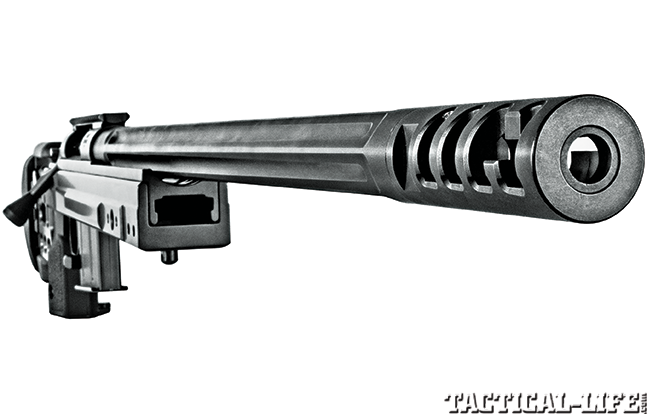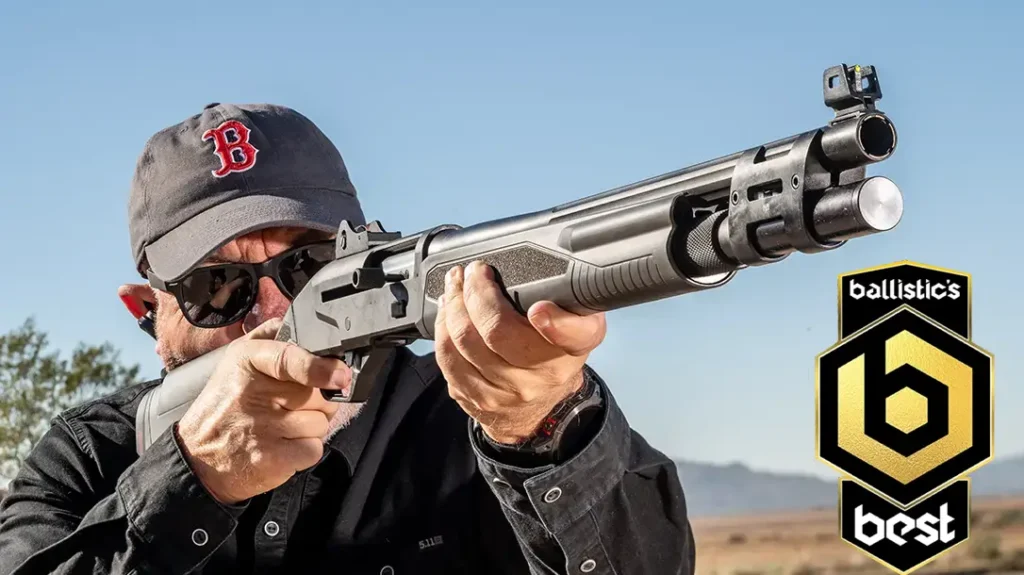It’s nice to see a company evolve over time. This evolution is most obviously traced in the products offered. Primary Weapons Systems (PWS) has recently expanded its product line. Joining PWS’ existing 5.56mm MK1, 7.62mm MK2 piston-driven ARs and T3 rimfire is the MK3 precision bolt action, which I recently got a chance to test. PWS has also decided to enter the direct-impingement AR world with its own “Modern Musket” offering.
- RELATED: Gun Test: Primary Weapons Systems’ Stealth MK212SD
- RELATED: Gun Review: Primary Weapons Systems PWS MK212 7.62mm Rifle
PWS first emerged as a leader in the quest for improving the AR operating system. In the process of doing this, PWS cultivated an almost cult following based on superior customer service, a unique interaction style with consumers and, most importantly, coming through on its promise to build superior AR rifles. PWS did not solely hang its hat on going with a short-stroke piston to improve Eugene Stoner’s direct-impingement AR design. The company took the less-traveled path by utilizing a long-stroke operating piston for its AR rifles, much like the AK-47’s, where the operating rod is connected to the bolt carrier. A short-stroke piston system consists of a more complex arrangement of tapped gas im-parting force to an operating rod that impacts another part of the mechanism that acts on the bolt carrier. PWS did not stop with the long-stroke piston; rather, the company insisted on top-quality components as well modifying the buffer tube connection to the receiver.
While PWS AR rifles are well known and respected, the company’s entry into the tactical bolt-action market is much less known. In the world of modern marketing, it is nice to discover a product in the catalog you feel should be the main story. Of course, I’m referring to the PWS MK3. Any law enforcement agency considering a bolt-action rifle should be comforted in knowing that the MK3 comes with a 0.5-MOA accuracy guarantee. Going further, PWS has balanced the MK3’s accuracy, weight and enhanced cartridge capabilities. The MK3 is designed so you can carry it for lengthy amounts of time and still be able to take a non-prone shot if dictated by the mission. The MK3 would make an excellent tactical rifle for law enforcement agencies, so let’s dig in further.
Advertisement — Continue Reading Below
Gun Details
The same principles that guided PWS’ AR journey are present in the MK3, a no-nonsense bolt action. Only after thoroughly surveying the precision bolt-action landscape did PWS move forward with the MK3 project. Currently, the company offers the MK3 chambered in .308, .338 Lapua Mag and .300 Win Mag, the latter of which I was able to test.
Advertisement — Continue Reading Below
The tale of the tape shows the MK3 is not a compact rifle; however, it is reasonably balanced and carries well. The .300 Win Mag variant features a 21.75-inch-long, 1-in-10-inch-twist barrel, bringing the rifle’s overall length to 44.24 inches. The rifle weighs 12.24 pounds unloaded. The heavy, fluted barrel is capped with PWS’ PRC compensator/muzzle brake, which gives the rifle a unique look. The PRC compensator is closed on the bottom and designed in a way to limit muzzle blast disturbance of surroundings.
PWS chose to outfit the MK3 with a KRG Whiskey-3 stock, or chassis, as well as a customized Model 700 action modified with a Sako-style extractor. The Whiskey-3 chassis’ side-folding buttstock pays homage to earlier USSOCOM PSR specifications and reduces the overall length by nearly 10 inches when folded for easier transportation. The Whiskey-3 chassis is rock solid, with design characteristics making it conducive to long-range shooting. The chassis reinforces the receiver like a sleeved benchrest rifle.
The wide, flat forend handles bipods or sandbags with equal aplomb. However, it is not exclusively designed for shooting from supported prone or benchrest positions. The MK3 allows for off-hand and other types of supported fire if needed. The ergonomics of the chassis allow for a comfortable, repeatable cheekweld combined with hand placement conducive to pulling the rifle’s Jewell trigger precisely. The Whiskey-3 chassis combines precise aluminum “V” bedding with tool-less adjustments in terms of length-of-pull and cheekpiece height. All of these elements contribute to the MK3’s ruggedness, ensuring constant and re-peatable accuracy no matter the conditions.
Advertisement — Continue Reading Below
As mentioned, the MK3 sports a single-stage Jewell unit with a pull weight between 3.5 and 4 pounds. The optics rail atop the receiver features a 20-MOA offset, allowing for extended-range zeroing.
The MK3 uses detachable Accuracy International AICS magazines, and a steel, single-stack, five-round mag comes with the rifle. The single-stack magazine design minimizes the amount of material removed from the stock and action for extra rigidity. The thought process behind using a single-stack magazine further exemplifies the attention to detail that went into making the PWS MK3; rounds are stripped straight from the magazine into the chamber, compared to other magazine designs where rounds are set at an angle to the rifle’s centerline.
Advertisement — Continue Reading Below
Range Time
To wring out the MK3’s accuracy, I chose three .300 Win Mag loads: Black Hills Match 190-grain BTHP, Federal Premium 190-grain Sierra MatchKing and Hornady 178-grain TAP A-MAX. Black Hills, Federal and Hornady are industry leaders, and these loads have proven themselves in other rifles I’ve tested.
At the range, I tested the rifle’s accuracy from a bench as well as from a prone position using a bipod and a rear sandbag. The accuracy figures are based on firing three 5-shot groups. The Federal and Black Hills ammunition produced the best 100-yard groups at only slightly above 0.5 inches.
Advertisement — Continue Reading Below
I didn’t spend a lot of time at the bench on the 100-yard range at the Echo Valley Training Center (EVTC). There are more indicative evaluations for a precision rifle than merely firing from a bench at a 100-yard target. So I also fired groups at 300 yards from field-expedient positions—prone with support from a bipod and a pack as well as from prepared “dug in” positions offered at EVTC—to further evaluate the MK3’s intrinsic accuracy. Again, the Federal and Black Hills loads performed the best. And, most importantly, the groups were still sub-MOA (smaller than 3 inches at 300 yards).
Next, I tested the PWS MK3 using a competition format I discovered at a local LE shoot that I attend annually. Competitors are tasked with engaging multiple hanging clay pigeons at 220 yards, more clay pigeons at 285 yards and then TacStrike quarter-scale steel targets placed at 350 yards. For this setup, shooters fire from a prone position supported by a bipod in front and a bag under the buttstock. The inherit accuracy of the PWS MK3 made short work of the course of fire. The oversized bolt handle and smooth action allowed for fast follow-up shots when engaging multiple targets. The MK3 stoutly ejected empty cases. The large ejection port also makes it quick and easy to load single cartridges into the chamber once the five-round magazine runs dry. The adjustable, well-designed buttstock, along with the PWS PRC compensator/muzzle brake, allowed me to rapidly engage multiple targets.
It was no problem riding the rifle’s recoil, working the action and engaging the next target. The Leupold Mark 4 6.5-20x scope I used at the range enabled effective holdovers with its mil-dot reticle. If preferred, a shooter can dial in the changes with the M1 turrets, especially as ranges beyond 600 yards. The PWS MK3 impressed me with its ability to place rounds on target, instilling confidence in its capabilities. I took a cold-bore shot at every opportunity during several visits to the range. The shot always landed where intended. Nothing instills more confidence in a tactical weapon system—the rifle, ammunition, optics and marksman—than the ability to place the first shot exactly as aimed.
Advertisement — Continue Reading Below
Marksman’s Notes
The PWS MK3 chambered in .300 Winchester Magnum is a significant ballistic step up compared to the more common 5.56mm and 7.62mm NATO found in LE use. The .300 WM offers superior terminal and flight ballistics as well as barrier penetration capabilities. Some of the tactical rifles available today—weighing over 16 pounds—reflect more of a target-shooting heritage than a tactical foundation. The PWS MK3’s 12.25-pound weight translates to a rifle that can be deployed or carried afield without overly fatiguing the marksman and is easier to adapt to non-standard firing positions, even off-hand, when needed. The .300 Winchester Magnum PWS MK3 should seriously be considered by any law enforcement agency requiring an upgrade in performance from its 5.56mm and 7.62mm NATO weapons.
Advertisement — Continue Reading Below
For more information, visit primaryweapons.com.
